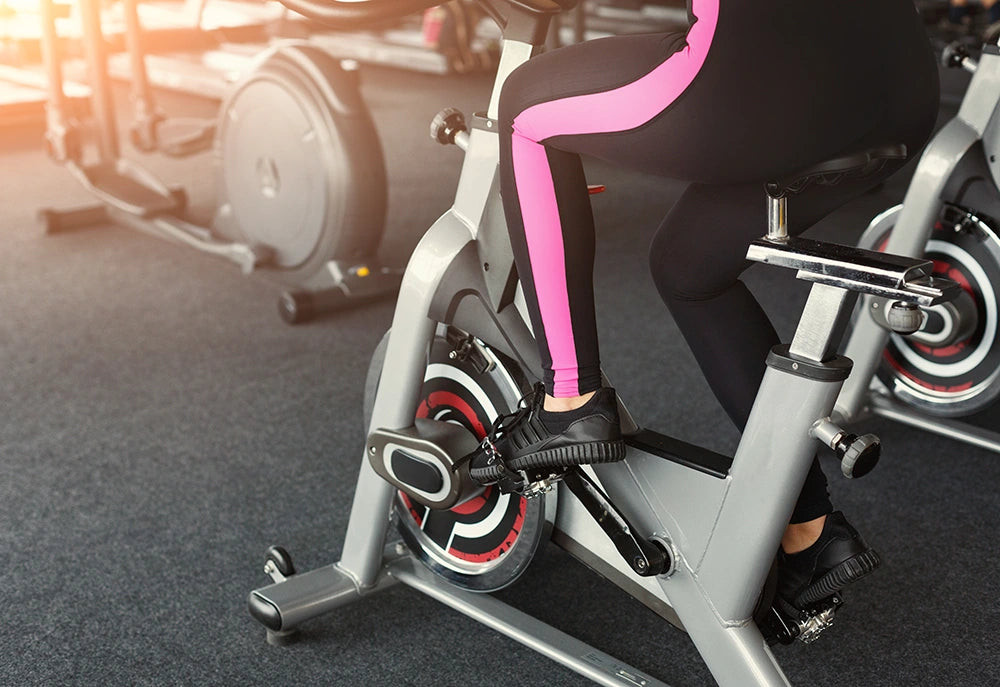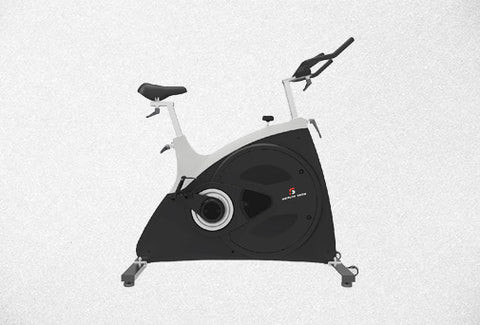Exercise bikes provide a fantastic low-impact workout, perfect for burning calories, boosting cardiovascular health, and building muscle strength. The best part? You can enjoy all these benefits from the comfort of your home, regardless of the weather outside.
Exercise bikes are incredibly user-friendly, making them accessible to almost anyone. Just hop on, adjust the settings to your liking, and start pedaling! There’s no need for complicated routines or gym classes. All you need is comfortable workout attire and supportive shoes to get started.
Regular exercise bike workouts offer a wide array of benefits, some of which might truly surprise you. Let’s dive into the many advantages of incorporating an exercise bike into your fitness regime.
What Exactly is an Exercise Bike?
An exercise bike is a stationary fitness machine designed to simulate the experience of riding a traditional bicycle. In today’s market, you’ll find a variety of indoor bike types, including air bikes, spin bikes, folding exercise bikes, and classic upright bikes. Each type offers a slightly different workout experience and caters to various fitness goals.
The primary purpose of exercise bikes is to enhance cardiovascular fitness. They are highly effective in helping to lower blood pressure, alleviate stress, strengthen the heart muscle, and regulate cholesterol levels. Many models come with adjustable resistance levels, making them suitable for individuals of all fitness levels, from beginners to seasoned athletes.
Unlocking the Top Exercise Bike Benefits
-
Strengthen Your Lower Body Muscles
Stationary cycling is an excellent way to target and strengthen your lower body muscles. It effectively works your quadriceps, hamstrings, glutes, and calf muscles. By simply increasing the resistance on your bike, you can intensify your workout and transform it into a more robust strength-training session.
Interestingly, exercise bikes can also engage your core muscles and even your arms, particularly models like air bikes that require more upper body engagement. So, consistent exercise biking not only leads to stronger legs but can also contribute to overall muscle development throughout your body.
 Woman using upright exercise bike at home for legs workout
Woman using upright exercise bike at home for legs workout -
Enhance Cardiovascular Health
Exercise bikes are renowned for their positive impact on heart health. Numerous studies have demonstrated that cycling significantly improves aerobic capacity and enhances the body’s efficiency in utilizing oxygen. Even short bursts of daily exercise, such as 10-minute sessions, can contribute to improved heart health and reduce the risk of heart disease. Incorporating High-Intensity Interval Training (HIIT) workouts on an exercise bike can further optimize oxygen utilization during exercise, leading to even greater cardiovascular benefits.
-
Efficient Calorie Burning for Weight Management
Many individuals turn to indoor cycling as an effective strategy for weight loss. A study conducted in Brazil in 2010 revealed that consistent biking over a 12-week period can aid in weight reduction when combined with a balanced diet. Participants in the study cycled for 45 minutes, three times per week, alongside dietary adjustments.
Further research reinforces these findings. A 2018 study involving sedentary women aged 32 to 47 showed that cycling three times a week for six weeks resulted in weight loss for some overweight participants, bringing them into a healthier weight range.
These studies highlight that regular biking is a valuable tool for weight management, especially when integrated with a healthy eating plan.
-
Boost Lung Capacity and Respiratory Function
While the cardiovascular benefits of exercise bikes are well-recognized, the positive effects on lung health are often underestimated.
Although indoor cycling may not be as intensely focused on respiratory training as activities like swimming or deep-sea diving, it still plays a crucial role in strengthening your lungs. Regular bike workouts improve overall muscle function and enhance your body’s ability to process oxygen. As you challenge yourself during exercise, your body adapts, leading to improved breathing efficiency and lung capacity over time.
-
Gentle on Joints: Low-Impact Exercise
Exercise bikes are exceptionally kind to your joints, making them an ideal exercise option for individuals of all ages and fitness levels, including those with joint sensitivities.
Indoor cycling is classified as a low-impact workout, especially when compared to high-impact activities like running or jumping. This means it places minimal stress on your knees, ankles, and hips. For individuals seeking joint-friendly exercise, particularly older adults, recumbent bikes are an excellent choice. They allow for effective cardiovascular workouts without putting undue strain on the body.
However, it’s essential to listen to your body. While generally low-impact, improper bike setup or overly intense workouts can still potentially stress your joints. For instance, prolonged standing on a spin bike, especially with incorrect form, can be demanding on the knees.
-
Improve Posture and Body Alignment
Beyond strengthening leg muscles and enhancing overall health, cycling can also contribute to improved posture. While most exercise bikes don’t enforce a rigid upright posture, they naturally encourage better body alignment when used correctly.
Maintaining a straight back while cycling is crucial for preventing injuries and maximizing benefits. This action helps strengthen the lower back muscles, which is particularly advantageous for individuals who spend long hours sitting, such as those with sedentary jobs. Cultivating good posture habits on an exercise bike can translate into improved posture and body mechanics in your daily life.
-
Make Workouts Enjoyable and Engaging
Exercise bikes sometimes suffer from the perception of being monotonous. However, modern exercise bike technology is rapidly changing this stereotype. Many newer models are equipped with internet connectivity and compatibility with mobile devices. This allows you to stream your favorite shows, movies, or even participate in virtual cycling classes while you exercise, making workouts more entertaining and less of a chore. Many people find indoor cycling more engaging than other forms of repetitive exercise, making it easier to stick to a consistent workout routine.
-
Experience Safer Workouts Compared to Road Cycling
Road biking, while enjoyable, inherently carries safety risks. Navigating cars, traffic, and unpredictable road conditions demands constant vigilance. In contrast, an exercise bike provides a secure and controlled environment. You can fully concentrate on your workout and fitness goals without the distractions and potential dangers of external hazards.
-
Customize Your Workout to Fit Your Needs
A significant advantage of exercise bikes is their adaptability. You have the power to tailor your workout to your specific fitness level and goals. With simple adjustments, often at the touch of a button, you can modify the resistance, incline (on some models), and workout programs. Whether you’re in the mood for a gentle recovery ride or a high-intensity, sweat-inducing session, exercise bikes offer complete control over your workout experience.
-
Effectively Reduce Stress and Improve Mood
Riding an exercise bike is not only physically beneficial but also a fantastic way to de-stress and unwind mentally. This type of cardiovascular exercise triggers the release of endorphins, natural mood-boosting chemicals in your brain. Regular exercise bike workouts can also contribute to better sleep quality, which in turn, significantly reduces overall stress levels and enhances your sense of well-being.
 SF spin bike in a home gym setup
SF spin bike in a home gym setup
Shop Now for Exercise Bikes
Exercise Bike Workout Ideas to Get You Started
Exercise bike workouts are incredibly versatile. From simple, steady-state sessions to challenging interval training, you can design routines to match any fitness level and preference.
Whether you’re seeking a low-impact workout on a recumbent bike for gentle cardio or a high-intensity ride to invigorate your mood and burn calories, there’s an exercise bike workout perfectly suited for you.
Beginner-Friendly Exercise Bike Workouts
Don’t be misled by the term “easy.” Even gentle workouts provide substantial health benefits. All forms of structured cardio are valuable, and varying intensity levels allow you to choose the best workout for your body each day. For example, a relaxed, consistent pace is ideal for active recovery after a strenuous strength training session.
You don’t need to be a seasoned cyclist to benefit. Keep it straightforward, focusing on a pace and resistance level that promotes recovery and relaxation rather than pushing yourself to exhaustion. Find a comfortable seat setting, put on your favorite music playlist, and enjoy a rejuvenating spin session.
Moderate Intensity Exercise Bike Workouts
Moderate exercise bike workouts encompass a wide spectrum of intensity levels, offering flexibility and progressive challenge. You might enjoy these workouts in a group cycling class or independently at home.
Interval training is an excellent method to maximize the challenge and effectiveness of a moderate workout. You don’t need to exert maximum effort during every interval; short bursts of higher intensity followed by periods of recovery can be incredibly efficient for improving fitness. Experiment with interval workouts to see how they integrate into your fitness regimen.
Challenging Exercise Bike Workouts for Advanced Fitness
Every well-rounded workout routine needs elements that push your limits. A demanding exercise bike workout is a fantastic way to break through plateaus, maintain motivation, and boost your fitness gains. Combining bike intervals with complementary exercises in a circuit training format is a highly effective approach to elevate the intensity.
No personal trainer is required. All you need is yourself, your exercise bike, and perhaps another piece of exercise equipment or bodyweight exercises.
A challenging bike workout doesn’t have to solely consist of sprints. Try incorporating a mix of full-body exercises, such as squats, push-ups, or lunges, interspersed with bike interval sets. This combination of strength training and cycling will keep your heart rate elevated and your workout dynamic and engaging.
Exercise Bike vs. Outdoor Cycling: Key Differences
Indoor and outdoor cycling both offer excellent workout experiences, but they differ in several aspects beyond just the location.
Your choice between indoor and outdoor cycling often depends on your lifestyle, environment, and cycling infrastructure in your area. Urban settings with limited green spaces or busy, unsafe streets might make indoor cycling a more practical and appealing option. Conversely, individuals with easy access to scenic bike paths and safe cycling routes might naturally gravitate toward outdoor rides.
Outdoor cycling typically includes natural breaks, such as coasting downhill or stopping at traffic signals, whereas indoor bikes generally require continuous pedaling. However, outdoor cycling also presents unique challenges, particularly when tackling uphill climbs. Steep inclines can put significant strain on your lower body and potentially lead to knee or quadriceps discomfort or injuries if not approached cautiously.
Interestingly, indoor cycling can sometimes feel more physically demanding subjectively, even if it isn’t objectively a tougher workout in terms of power output or calorie burn. Factors such as increased sweat production due to less air circulation, limited body movement compared to outdoor cycling (where you balance and steer), and the focused, continuous nature of indoor cycling can contribute to this perception of increased exertion.
Frequently Asked Questions About Exercise Bike Benefits (FAQs)
-
How do exercise bikes actually work to provide resistance?
Exercise bikes create resistance against the pedals, allowing you to adjust the intensity of your workout. This resistance is typically generated using various mechanisms, such as friction, magnetic resistance, or air resistance systems. -
How often should I use an exercise bike per week to see noticeable fitness improvements?
For optimal results, aim for 3-5 exercise bike workouts per week, with each session lasting between 20-30 minutes. Consistency is key to improving your fitness level and overall health. -
Can exercise bikes really be effective for weight loss?
Yes, exercise bikes are a valuable tool for weight loss when incorporated into a holistic approach that includes a balanced diet and regular physical activity. Cycling burns calories and helps create a calorie deficit, essential for weight reduction. -
Are exercise bikes a suitable and safe exercise option for seniors?
Absolutely. Exercise bikes are an excellent low-impact workout choice, particularly well-suited for seniors who want to maintain an active lifestyle without placing excessive stress on their joints. -
How can I maintain motivation and prevent boredom while using an exercise bike regularly?
To stay motivated, try incorporating variety into your workouts. Explore different workout styles, listen to energizing music or engaging podcasts, watch motivating videos or virtual cycling tours, or set progressive fitness goals to keep your sessions interesting and rewarding. -
Are exercise bikes safe and appropriate for individuals with existing knee pain or issues?
Often, yes. Exercise bikes generally provide a low-impact form of exercise that can be beneficial for individuals with knee pain, as it minimizes stress on the knee joints compared to weight-bearing activities. However, it’s always prudent to consult with a healthcare professional or physical therapist for personalized advice, especially if you have pre-existing knee conditions. -
What are the primary types of exercise bikes available, and how do I choose the right one for my needs?
The main types of exercise bikes include upright bikes, recumbent bikes, and spin bikes. Consider factors such as your comfort preferences, desired workout intensity levels, any specific physical limitations, and available space in your home when making your choice. Recumbent bikes offer back support, upright bikes mimic regular cycling, and spin bikes are designed for intense, class-style workouts. -
Can exercise bikes help specifically target and burn belly fat?
Yes, consistent stationary bike riding contributes to overall body fat reduction, which includes belly fat. However, it’s important to understand that spot reduction (selectively losing fat in a specific area) is generally not achievable through exercise alone. A combination of regular exercise and a balanced diet is crucial for effective belly fat reduction and overall fat loss. -
Which specific muscle groups are primarily engaged when riding an exercise bike?
Exercise bikes primarily target the muscles in your lower body, including the glutes, quadriceps, hamstrings, and calf muscles. Certain exercise bike models, particularly those that incorporate upper body movement, can also engage your core and arm muscles to a lesser degree. -
Is exercising on an exercise bike for 30 minutes a day sufficient to see health benefits?
Yes, dedicating 30 minutes a day to exercise bike workouts is a fantastic starting point and provides significant health benefits. It can improve your cardiovascular health, elevate your mood, and burn calories. For more ambitious fitness goals or significant weight loss, you may need to gradually increase the duration or intensity of your workouts. -
Is it possible to achieve a good level of overall fitness solely by using a stationary bike?
While consistent stationary bike use can certainly improve your overall fitness level, a well-rounded fitness routine is generally considered ideal for optimal health. Incorporating strength training exercises and other forms of varied physical activity alongside exercise biking will help you achieve more balanced muscle development and prevent fitness plateaus. -
For individuals aiming to lose weight, how long should they ideally use an exercise bike each day?
The optimal duration for exercise bike use for weight loss is influenced by various factors, including your individual diet, overall daily activity level, and metabolism. While increasing exercise bike usage can contribute to weight loss, aiming for at least 30-60 minutes of moderate-intensity exercise on most days of the week is a solid starting guideline. Listen to your body, and gradually increase duration and intensity as your fitness improves.

